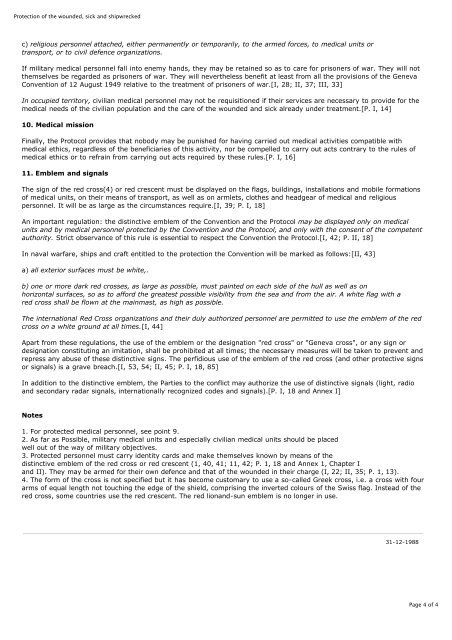The Law of War
The Law of War
The Law of War
Create successful ePaper yourself
Turn your PDF publications into a flip-book with our unique Google optimized e-Paper software.
Protection <strong>of</strong> the wounded, sick and shipwrecked<br />
c) religious personnel attached, either permanently or temporarily, to the armed forces, to medical units or<br />
transport, or to civil defence organizations.<br />
If military medical personnel fall into enemy hands, they may be retained so as to care for prisoners <strong>of</strong> war. <strong>The</strong>y will not<br />
themselves be regarded as prisoners <strong>of</strong> war. <strong>The</strong>y will nevertheless benefit at least from all the provisions <strong>of</strong> the Geneva<br />
Convention <strong>of</strong> 12 August 1949 relative to the treatment <strong>of</strong> prisoners <strong>of</strong> war.[I, 28; II, 37; III, 33]<br />
In occupied territory, civilian medical personnel may not be requisitioned if their services are necessary to provide for the<br />
medical needs <strong>of</strong> the civilian population and the care <strong>of</strong> the wounded and sick already under treatment.[P. I, 14]<br />
10. Medical mission<br />
Finally, the Protocol provides that nobody may be punished for having carried out medical activities compatible with<br />
medical ethics, regardless <strong>of</strong> the beneficiaries <strong>of</strong> this activity, nor be compelled to carry out acts contrary to the rules <strong>of</strong><br />
medical ethics or to refrain from carrying out acts required by these rules.[P. I, 16]<br />
11. Emblem and signals<br />
<strong>The</strong> sign <strong>of</strong> the red cross(4) or red crescent must be displayed on the flags, buildings, installations and mobile formations<br />
<strong>of</strong> medical units, on their means <strong>of</strong> transport, as well as on armlets, clothes and headgear <strong>of</strong> medical and religious<br />
personnel. It will be as large as the circumstances require.[I, 39; P. I, 18]<br />
An important regulation: the distinctive emblem <strong>of</strong> the Convention and the Protocol may be displayed only on medical<br />
units and by medical personnel protected by the Convention and the Protocol, and only with the consent <strong>of</strong> the competent<br />
authority. Strict observance <strong>of</strong> this rule is essential to respect the Convention the Protocol.[I, 42; P. II, 18]<br />
In naval warfare, ships and craft entitled to the protection the Convention will be marked as follows:[II, 43]<br />
a) all exterior surfaces must be white,.<br />
b) one or more dark red crosses, as large as possible, must painted on each side <strong>of</strong> the hull as well as on<br />
horizontal surfaces, so as to afford the greatest possible visibility from the sea and from the air. A white flag with a<br />
red cross shall be flown at the mainmast, as high as possible.<br />
<strong>The</strong> international Red Cross organizations and their duly authorized personnel are permitted to use the emblem <strong>of</strong> the red<br />
cross on a white ground at all times.[I, 44]<br />
Apart from these regulations, the use <strong>of</strong> the emblem or the designation "red cross" or "Geneva cross", or any sign or<br />
designation constituting an imitation, shall be prohibited at all times; the necessary measures will be taken to prevent and<br />
repress any abuse <strong>of</strong> these distinctive signs. <strong>The</strong> perfidious use <strong>of</strong> the emblem <strong>of</strong> the red cross (and other protective signs<br />
or signals) is a grave breach.[I, 53, 54; II, 45; P. I, 18, 85]<br />
In addition to the distinctive emblem, the Parties to the conflict may authorize the use <strong>of</strong> distinctive signals (light, radio<br />
and secondary radar signals, internationally recognized codes and signals).[P. I, 18 and Annex I]<br />
Notes<br />
1. For protected medical personnel, see point 9.<br />
2. As far as Possible, military medical units and especially civilian medical units should be placed<br />
well out <strong>of</strong> the way <strong>of</strong> military objectives.<br />
3. Protected personnel must carry identity cards and make themselves known by means <strong>of</strong> the<br />
distinctive emblem <strong>of</strong> the red cross or red crescent (1, 40, 41; 11, 42; P. 1, 18 and Annex 1, Chapter I<br />
and II). <strong>The</strong>y may be armed for their own defence and that <strong>of</strong> the wounded in their charge (I, 22; II, 35; P. 1, 13).<br />
4. <strong>The</strong> form <strong>of</strong> the cross is not specified but it has become customary to use a so-called Greek cross, i.e. a cross with four<br />
arms <strong>of</strong> equal length not touching the edge <strong>of</strong> the shield, comprising the inverted colours <strong>of</strong> the Swiss flag. Instead <strong>of</strong> the<br />
red cross, some countries use the red crescent. <strong>The</strong> red lionand-sun emblem is no longer in use.<br />
31-12-1988<br />
Page 4 <strong>of</strong> 4

















